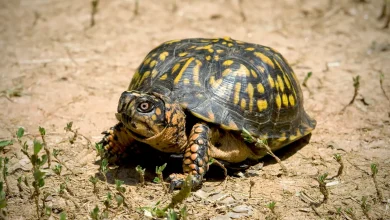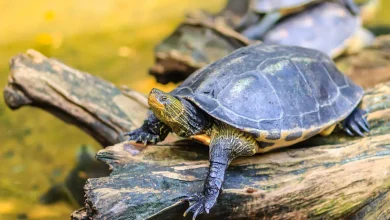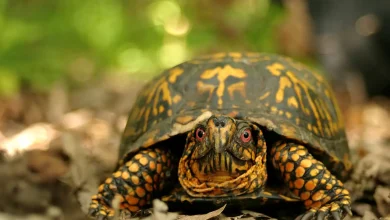Yucatan Box Turtle (Terrapene Carolina Yucatana)
The Yucatan Box Turtle is a subspecies of the common box turtle, Terrapene Carolina.
- Terrapene Carolina Yucatana – Boulenger, 1895
Table of Contents
Yucatan Box Turtle Distribution
The Yucatan Box Turtle is an endemic species, meaning that the entire known species is isolated to a single area. The only known location of the Yucatan Box Turtle is the Yucatan peninsula of Mexico, for which the turtle is named after. It is the southernmost subspecies of box turtle and is heavily isolated from the other subspecies; more so than any other type of box turtle. When first discovered, it was even believed not to be a subspecies but an independent species of its own.
Acquiring one in the United States is almost impossible. There are only a few examples of Yucatan Box Turtles being kept in captivity in America. Few studies have been done and little information is available; but the locals of Yucatan believe that the turtle’s population may be dwindling.
Yucatan Box Turtle Habitat
All subspecies of box turtle love humidity, but this is especially true for the tropical Yucatan Box Turtle. As mentioned earlier, their only known location is on the peninsula of Yucatan Mexico. They live within the tropical forestry and are an elusive species. They are rarely encountered by humans are often only seen during or after rain. They seem to be very inactive year round except for the rainy seasons.
Their already isolated habitat is shrinking in recent years, and sightings are becoming rare.
Body
The Yucatan Box Turtle can reach about 6 inches in length. The species is unique in that the males especially have quite interesting pigmentation. For instance, some specimens have white faces, pigmented so strongly that it is almost reminiscent of makeup.
As is the case with all box turtles, the Yucatan Box Turtle has a hinged shell which allows it to encase itself entirely.
Sexing a Yucatan Box Turtle
As mentioned earlier, the males of the species tend to have profound and interesting pigmentation; such as white faces. The females have far less coloration by comparison, in some cases; the difference in pigmentation is so profound that male and female specimens look like two entirely different species.
A way that you can determine the gender for box turtles is to examine the bottom of their shell. Males will typically have a concave curve on the bottom of their shell, whereas females do not. The purpose of this is to help the males mount the females during mating.
What Does a Yucatan Box Turtle Eat?
The Yucatan Box Turtle is an omnivore; as are all subspecies of box turtle. This term means that the species eats both meat and plant matter. Yucatan Box Turtles in captivity have been shown to eagerly accept a wide variety of food options; and some speculate there is little they won’t eat in the wild.
Common favorites for most subspecies are insects, which are easy to hunt and kill for protein in shallow bodies of water. Slugs, snails, cockroaches and crickets are all examples of insects a box turtle would happily eat. For plant matter they enjoy certain types of moss and grass, fruits, berries, and mushrooms.
How Old can a Yucatan Box Turtle Get?
Yucatan Box Turtles have not been studied extensively or for very long. But subspecies of box turtles in general are believed to live to around a hundred years in the wild. This number is often significantly lower when kept in captivity. Box turtles have a strong attachment to where they are born, rarely traveling far from where they were hatched. When taken from their familiar environment, there is often a profound level of stress which can contribute to their shortened lifespan.
Keeping Yucatan Box Turtles as Pets
A Yucatan Box Turtle is not a practical subspecies to pursue as a pet. The species is heavily understudied and specimens are difficult to obtain. Even the locals who live in the same region as them report few sightings of these illusive turtles.
Housing a Yucatan Box Turtle
Few known Yucatan Box Turtles are kept in captivity. It could be assumed that many of the general rules of thumb that apply to most subspecies of box turtle would also apply to the Yucatan Box Turtle when constructing an enclosure.
Humidity would be extremely vital for a Yucatan Box Turtle. At the very least this would have to include a spray bottle being used many times throughout the day.
Glass is a difficult concept for box turtles to comprehend, and can be extremely stressful for them. They will often try endlessly to escape through the invisible wall. You can greatly improve their health and happiness by having an enclosure they cannot see through such as wooden enclosure or plastic tub.
Fresh water is vital. There must be clear water for them to drink from or soak in at all times.
Isolation is important for the turtle to feel safe. Even though box turtles can hide inside their shells, they still crave an external barrier of privacy. Brush and logs can make them feel safer, as well as soft bedding that they can burrow into.
A heating lamp is required to provide the cold blooded creature with warmth. This should be placed to one side of the enclosure so that the turtle can move closer to or further away from the heat source as needed.
Feeding a Yucatan Box Turtle
Yucatan Box Turtles are omnivores so they need a mixture of meat and plant matter in their diet. Most small insects work well for box turtles, such as feeder crickets or feeder grubs from any local pet store. For plant matter, lettuce, fruits and berries are often eagerly accepted by box turtles.
Box turtles need to have a healthy balance of both meat and plant matter in their diet, or else they may not get all of the nutrients they need to survive.
References
- Boulenger, G. A. 1895. On the American Box-tortoises. Ann. Mag. nat. Hist. (6)15: 330-331
- Iverson, J. B. 1992. A Revised Checklist with Distribution Maps of the Turtles of the World



